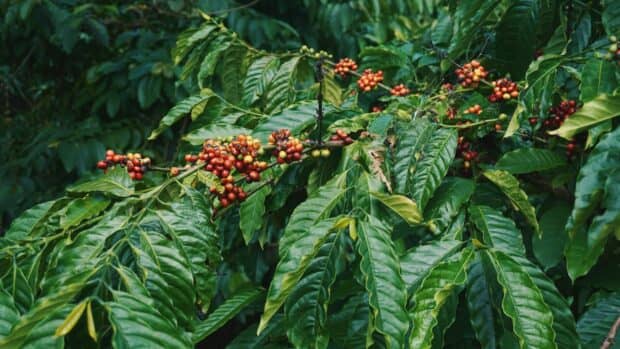[[{“value”:”
Coffee production in Vietnam for the 2024/25 year is forecast to remain steady at approximately 29 million 60-kilogram bags (robusta and arabica combined).
A continued period of favorable global prices for green coffee have incentivized production. Conversely, the continued effects of high temperatures, increased drought, aging farms and higher prices for other crops have diminished production and export potential.
These and other issues are outlined in the new USDA Foreign Agriculture Service annual report on the Vietnam coffee sector.
[Note: This is part of a series of stories that will explore USDA FAS annual coffee reports. The information agency typically delivers more than a dozen country-level reports on the coffee sector, each coming from different authors and field offices, with predictions for the 2024/25 market year.]
Production Estimates
Vietnam’s coffee production for market year 2024/25 is forecast to remain stable, at the equivalent of 29 million 60-kilo bags, with higher coffee prices helping to offset production decline trends, according to the analysis.
Robusta production is expected to reach 27.85 million bags, while arabica production is forecast at 1.15 million bags.
Increased investments in labor and inputs led to an estimated 6% rise in estimated production for the 2023/24 coffee production year, resulting in 29.1 million bags, according to the report.
Crop Area
Vietnam’s coffee area is expected to remain stable at around 600,000 hectares, although the authors noted that farmers in the Central Highlands are diversifying to higher-earning crops like durian and passion fruit.
High temperatures and droughts, exacerbated by climate change, have negatively impacted coffee production in 2023/24, with low forest cover and falling groundwater levels posing long-term challenges.
Irrigated and shaded coffee fields have fared best through the adverse weather conditions, although the analysis warns that maintaining current production levels may be difficult if such conditions persist.
Policy and Land Use
The provincial Department of Agriculture and Rural Development (DARD) and Western Highland Agriculture and Forest Science Institute (WASI) have developed strategies for sustainable coffee production, including replacing old trees with new varieties, promoting intercropping, adopting water-saving irrigation systems and helping farmers certify their farms for higher prices, according to the report.
The central government’s coffee re-cultivation program has replanted 130,000 hectares of old coffee farms with new plants, increasing yields to 2.8-3.0 tons/hectare, and plans to replant an additional 100,000 hectares by 2025, according to the report.
According to a report by the International Union for Conservation of Nature (IUCN), the water demand for coffee mono-culture production in the highland region of Vietnam is about 1.12 billion cubic meters a year.
Exports
Coffee exports from Vietnam reached 15.94 million bags in the first half of 2023/24, a 7% decrease from the previous year, with significant drops in exports to Belgium, the United States and Germany, but increases to Spain, Japan and Algeria, according to customs reports.
2023/24 export forecasts were raised to 26.85 million bags due to strong trade statistics and high export prices, though high domestic prices and stock retention by farmers pose challenges for future exports.
The EU’s upcoming deforestation-free regulation is a concern for Vietnam’s coffee farmers, especially small-scale producers, who hope existing certification programs like 4C will help meet the new requirements.
Consumption
Vietnam’s economy grew 5.6 percent in Q1 2024, but consumption only increased by 4.9 percent, attributed to slowed job and income growth.
Coffee consumption is estimated to reach 3.6 million bags in MY 2024/25, with MY 2023/24 consumption raised to 3.45 million bags due to strong demand.
The authors noted that Vietnam maintains a strong coffee-drinking culture, with a particular emphasis on budget-friendly drinks plus a growing high-end arabica market.
Comments? Questions? News to share? Contact DCN’s editors here.
Related Posts
“}]]


